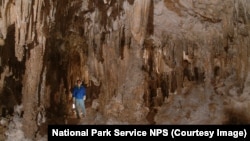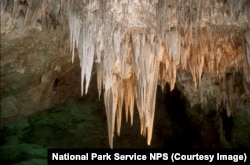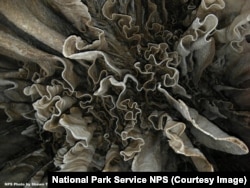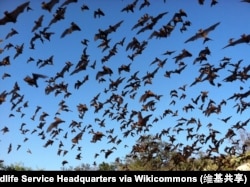This week, we explore a national park -- and UNESCO World Heritage Site -- in the American Southwest.
This national park, near the city of Carlsbad, New Mexico, is unusual in a major way --- it is mostly underground.
Carlsbad Caverns National Park contains more than 100 caves below the surface of the desert. Most are closed to the public. But anyone can visit the main attraction, one of the largest caves in the world.
Huge. Incredible. Inspiring. Words like these come to mind as visitors enter a world of silence, darkness and cold, almost 230 meters under the ground.
An elevator lowers you into the world of Carlsbad Cavern. It is silent, except for the quiet voices of guides and visitors. It is not fully dark though. The National Park Service has enough lighting to see many of the beautiful formations all around. The temperature in the cave is about 13 degrees Celsius.
A cavern is a large cave. But Carlsbad Cavern is really a long series of chambers. One of these is called the Big Room. The Big Room measures more than three hectares. The ceiling is 77 meters high. The Big Room is the single largest underground chamber ever found in North America.
The Big Room and other parts of the cavern contain huge, sharp formations of minerals. People are free to explore the lit formations in the Big Room. But park rangers must guide visitors to other areas of the cave.
Stalactites hang from the ceiling. Stalagmites rise from the floor. Some even meet to create a column. Other formations look like needles, popcorn, pearls and flowers.
One of the first questions visitors might have is how did Carlsbad Cavern form? Guides explain that it did not result from the action of waterways like other limestone caves. Its creator was sulfuric acid.
The limestone developed about 250 million years ago. Then, within the last 20 million years, movements in the earth pushed the rock upward, forming the Guadalupe Mountains. Today these mountains extend from west Texas into southeast New Mexico.
The action of oil and natural gas created hydrogen sulfide in the limestone. The hydrogen sulfide reacted with oxygen in rainwater moving through the rock. Sulfuric acid developed. The acid created the caves by dissolving the limestone in its path.
Later, the water and most of the acid left the caves as the Guadalupe Mountains continued to rise. This permitted freshwater to move through. The freshwater left behind minerals. These minerals became the formations and shapes on the ceilings, walls and floors of the caves.
People are not the only visitors to Carlsbad Caverns National Park. About 400,000 Mexican free-tailed bats come from Mexico every summer to give birth in the big cave.
As the sun goes down each day, thousands of adult bats fly out of the cave. It can take from 20 minutes to more than two hours for them all to leave. They go to nearby river valleys to feed on insects. Then, toward morning, they return to the bat cave within Carlsbad Cavern.
Park Service rangers explain that mother bats find their babies by remembering their location, their smell and the sound of their cry. Mothers and their babies, called pups, hang in groups on the ceiling. They spend the day resting and feeding.
While the adults go out at night for food, the young bats hang out in the cave for four or five weeks. Then, in July or August, they join their mothers on these nightly flights.
Finally, in late October or early November, the bats all leave and return to Mexico. But they always come back the next year.
It is possible that it was the bats that led ancient people to discover the cave. Archaeologists and others have found evidence of Ice Age hunters near the cave entrance. They have also found pieces of spear points left about 10,000 years ago.
More recently, Apache Indians painted pictures at the entrance. And evidence of one of their cooking areas was found beside a nearby path.
Around 1900, a teenage cowboy named James Larkin White began to explore the cave. Jim White told his story in the 1932 book, "The Discovery and History of Carlsbad Caverns." Here is a reading of his description of his first sight of the bats and the big cave:
"I thought it was a volcano, but then, I’d never seen a volcano -- nor never before had I seen bats swarm, for that matter. During my life on the range I’d seen plenty of prairie whirlwinds -- but this thing didn’t move; it remained in one spot, spinning its way upward. I watched it for perhaps a half-hour -- until my curiosity got the better of me. Then I began investigating …"
Jim White told how he built a ladder from rope, wire and sticks and returned to the entrance of the cave a few days later.
"Standing at the entrance of the tunnel I could see ahead of me a darkness so absolutely black it seemed a solid. The light of my lantern was but a sickly glow. Nevertheless, I forged ahead, and with each step the tunnel grew larger, and I felt as though I was wandering into the very core of the Guadalupe Mountains."
Several years later, in 1918, Jim White took a professional photographer into the cave. Ray Davis' pictures of the Big Room appeared in the New York Times newspaper. National interest began to grow.
In 1923, scientists from the National Geographic Society explored the caves. The following year, President Calvin Coolidge named Carlsbad a national monument. Presidents can declare national monuments, but Congress must act to establish a national park. And that is what Congress did in 1930.
Since then, parts of Carlsbad Caverns have been used for movie sets, weddings, even meetings of the Carlsbad City Council.
Most visitors go to the main cavern. But some experienced cavers are permitted to explore five "wild" caves in the park. And, in another one, scientists are studying microbes in search of a cure for cancer.
As for Jim White, he became chief ranger of Carlsbad Caverns. In one story in his book, he talks about all the work that was done in the area.
"I doubt if you can understand how happy this modernizing has made me. It's like the pleasant end to a dream."
I'm Ashley Thompson.
And I'm Caty Weaver.
Ashley Thompson adapted this report from VOA Learning English archive materials written by Nancy Steinbach. Caty Weaver was the editor.
_______________________________________________________________
Words in This Story
attraction - n. something interesting or enjoyable that people want to visit, see, or do
incredible - adj. extremely good, great, or large
inspiring - adj. causing people to want to do or create something or to lead better lives
elevator - n. a machine used for carrying people and things to different levels
chamber - n. a small space inside something
swarm - v. to move in a large group
prairie - n. a large, mostly flat area of land in North America that has few trees and is covered in grasses
whirlwind - n. a very strong wind that moves in a spinning or swirling motion and that can damage buildings, trees, etc.
range - n. open land that farm animals (such as cows and sheep) use for feeding and roaming

















